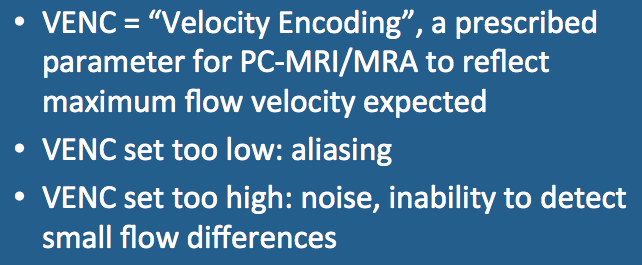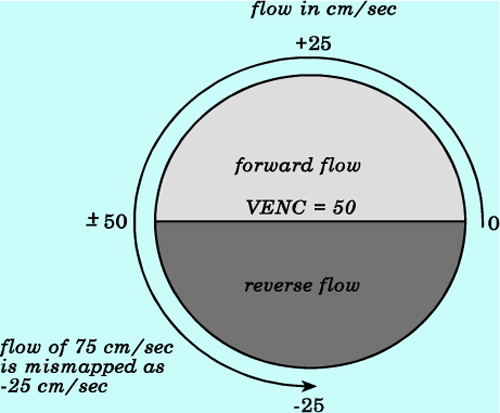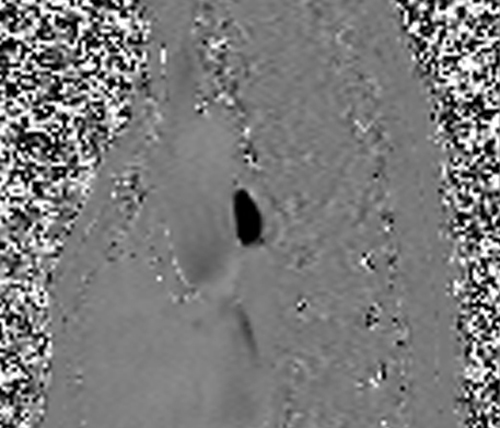VENC stands for velocity encoding, a parameter that must be specified before performing a phase-contrast (PC) MRI or MRA study. VENC, measured in cm/sec, should be chosen to encompass the highest velocities likely to be encountered within the vessel of interest. If VENC is set to 50 cm/sec, for example, flows in the range of ±50 cm/sec can be accurately represented by a set of phase shifts spanning from −180° to +180°.
The VENC parameter adjusts the strength of the bipolar gradients so that the maximum velocity selected corresponds to a 180° phase shift in the data. VENC is inversely related to the size of these gradients. Larger gradients create more dephasing and correspond to smaller values of VENC.
The VENC setting is critical for proper performance of the PC pulse sequence, but usually can only be estimated since its optimal value is generally not known in advance. Often a study will be repeated using 2-3 different VENCs based on typical velocities expected.
If the selected VENC is set too high, the range of flows imaged will span only a limited phase shift range. The signal-to-noise of the image and quality of the data will suffer. Small velocity differences on flow studies will not be distinguishable, and vessels with slow flow may be impossible to see.
The VENC parameter adjusts the strength of the bipolar gradients so that the maximum velocity selected corresponds to a 180° phase shift in the data. VENC is inversely related to the size of these gradients. Larger gradients create more dephasing and correspond to smaller values of VENC.
The VENC setting is critical for proper performance of the PC pulse sequence, but usually can only be estimated since its optimal value is generally not known in advance. Often a study will be repeated using 2-3 different VENCs based on typical velocities expected.
If the selected VENC is set too high, the range of flows imaged will span only a limited phase shift range. The signal-to-noise of the image and quality of the data will suffer. Small velocity differences on flow studies will not be distinguishable, and vessels with slow flow may be impossible to see.
|
If VENC is picked too low, velocity aliasing may occur with faster flows not being appropriately represented. For example, if the chosen value of VENC is 50 cm/sec, the bipolar gradient is adjusted so that a flows of +25 and +50 cm/sec are assigned a phases of +90° and +180° respectively. If the actual velocity is +75 cm/sec, this flow will be mapped to +270°, a value that cannot be distinguished from a phase shift of −90°. Instead of representing the +75-cm/sec flow as its actual velocity, the computer will assign it a flow of 25 cm/sec in the opposite direction!
|
Proper estimation of VENC is thus critical for successful of PC angiography. As a general rule, choosing VENC about 20−25% higher than the maximum expected flow velocity is advised.
Advanced Discussion (show/hide)»
No supplementary material yet. Check back soon.
References
Lotz J, Meier C, Leppert A, Galanski M. Cardiovascular flow measurement with phase-contrast MR imaging: basic facts and implementation. Radiographics 2002; 22:651-671.
Lotz J, Meier C, Leppert A, Galanski M. Cardiovascular flow measurement with phase-contrast MR imaging: basic facts and implementation. Radiographics 2002; 22:651-671.
Related Questions
How does phase-contrast MR angiography work?
What are the usual velocities of blood found in the human vascular system?
How does phase-contrast MR angiography work?
What are the usual velocities of blood found in the human vascular system?



